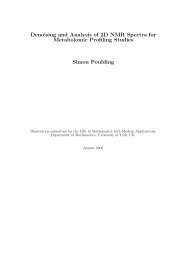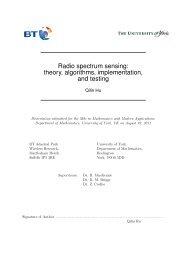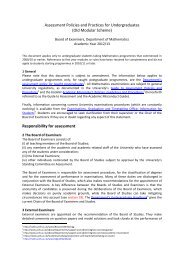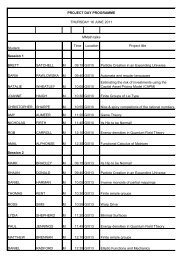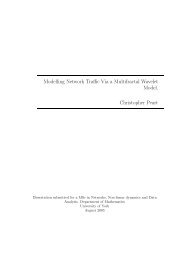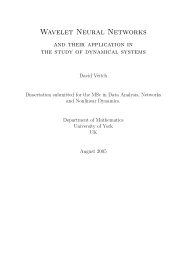The El Farol Bar Problem for next generation systems
The El Farol Bar Problem for next generation systems
The El Farol Bar Problem for next generation systems
Create successful ePaper yourself
Turn your PDF publications into a flip-book with our unique Google optimized e-Paper software.
3.2. TAXING/PAYOFFS ALGORITHMS 27<br />
In the following a set of equations that describe the stationary state behaviour<br />
of the probabilities will be derived pi(k).<br />
<strong>The</strong> number of agents attending at time k is N(k) = M i=1 xi(k) and xi(k) are<br />
independent Bernoulli trials given by:<br />
<br />
1, pi(k)<br />
xi(k) =<br />
(3.2.5)<br />
0, 1 − pi(k)<br />
In the stationary state we have:<br />
pi(k + 1) = pi(k) ∀i ∈ N<br />
Taking the expectation values results to:<br />
E(pi(k + 1)) = E(pi(k)) ⇒ E(pi(k + 1)) − E(pi(k)) = 0 ⇒<br />
E(µtax(N(k) − N )) = 0<br />
N(k) is the number of agents attending at time k is equal to M i=1 xi(k), where<br />
xi(k) are independent Bernoulli trials.<br />
<strong>The</strong> expectation value is calculated using the following <strong>for</strong>mula:<br />
E(XY ) = <br />
fx,y(x, y)<br />
where X,Y random variables and fx,y(x, y) joined mass function. In this case<br />
Y = µtax and X = N(k) − N . By definition, Y = µtax is a function of N(k). So,<br />
Y = g(X) and fx,y(x, y) = fx(x, g(x)) = fx(x). Hence:<br />
E(µtax(N(k)) · (N(k) − N )) = <br />
(N(k) − N ) · µtax(N(k)) · fN(k)(N(k)) ⇒<br />
cµ <br />
N(k)>N<br />
N(k)−N<br />
(N(k) − N ) · fN(k)(N(k)) + µ <br />
cµ <br />
N(k)>N<br />
µ <br />
N(k)≤N<br />
x<br />
N(k)≤N<br />
N(k) · fN(k)(N(k)) − cµN <br />
(N(k) − N ) · fN(k)(N(k)) ⇒<br />
N(k)>N<br />
N(k) · fN(k)(N(k)) − µN <br />
N(k)≤N<br />
fN(k)(N(k))+<br />
fN(k)(N(k)) (3.2.6)<br />
Kolmogorov-Smirnov test indicated that z = N(k) might follow Poisson distribution<br />
f(z) = λz<br />
z! e−λ , with λ = E(z). Hence:<br />
E(f(z)) = <br />
zf(z) = <br />
zf(z) + <br />
zf(z) = λ ⇒<br />
z<br />
z≤N<br />
z>N



